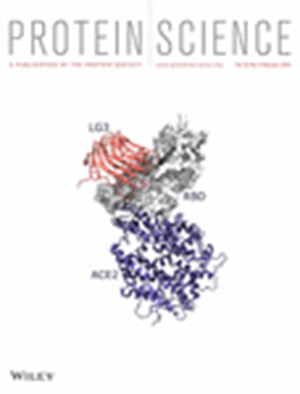iLight2: A near‐infrared optogenetic tool for gene transcription with low background activation
IF 4.5
3区 生物学
Q1 BIOCHEMISTRY & MOLECULAR BIOLOGY
引用次数: 0
Abstract
Optogenetic tools (OTs) operating in the far‐red and near‐infrared (NIR) region offer advantages for light‐controlling biological processes in deep tissues and spectral multiplexing with fluorescent probes and OTs acting in the visible range. However, many NIR OTs suffer from background activation in darkness. Through shortening linkers, we engineered a novel NIR OT, iLight2, which exhibits a significantly reduced background activity in darkness, thereby increasing the light‐to‐dark activation contrast. The resultant optimal configuration of iLight2 components suggests a molecular mechanism of iLight2 action. Using a biliverdin reductase knock‐out mouse model, we show that iLight2 exhibits advanced performance in mouse primary cells and deep tissuesiLight2:用于基因转录的低背景激活的近红外光遗传工具
在远红外和近红外(NIR)区域工作的光遗传工具(OTs)在深部组织的光控生物过程以及与荧光探针和在可见光范围工作的 OTs 进行光谱复用方面具有优势。然而,许多近红外 OT 在黑暗中会受到背景激活的影响。通过缩短连接体,我们设计出一种新型近红外 OT iLight2,它在黑暗中的背景活性显著降低,从而提高了明暗激活对比度。iLight2 成分的最佳配置结果表明了 iLight2 的分子作用机制。利用胆绿素还原酶基因敲除小鼠模型,我们证明了 iLight2 在小鼠原代细胞和体内深层组织中表现出的先进性能。伤口愈合细胞模型中高效的光控细胞迁移证明了 iLight2 用于治疗的可能性,总体而言,iLight2 是近红外 OT 工具包中基因转录应用的重要补充。
本文章由计算机程序翻译,如有差异,请以英文原文为准。
求助全文
约1分钟内获得全文
求助全文
来源期刊

Protein Science
生物-生化与分子生物学
CiteScore
12.40
自引率
1.20%
发文量
246
审稿时长
1 months
期刊介绍:
Protein Science, the flagship journal of The Protein Society, is a publication that focuses on advancing fundamental knowledge in the field of protein molecules. The journal welcomes original reports and review articles that contribute to our understanding of protein function, structure, folding, design, and evolution.
Additionally, Protein Science encourages papers that explore the applications of protein science in various areas such as therapeutics, protein-based biomaterials, bionanotechnology, synthetic biology, and bioelectronics.
The journal accepts manuscript submissions in any suitable format for review, with the requirement of converting the manuscript to journal-style format only upon acceptance for publication.
Protein Science is indexed and abstracted in numerous databases, including the Agricultural & Environmental Science Database (ProQuest), Biological Science Database (ProQuest), CAS: Chemical Abstracts Service (ACS), Embase (Elsevier), Health & Medical Collection (ProQuest), Health Research Premium Collection (ProQuest), Materials Science & Engineering Database (ProQuest), MEDLINE/PubMed (NLM), Natural Science Collection (ProQuest), and SciTech Premium Collection (ProQuest).
 求助内容:
求助内容: 应助结果提醒方式:
应助结果提醒方式:


